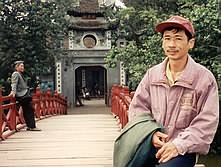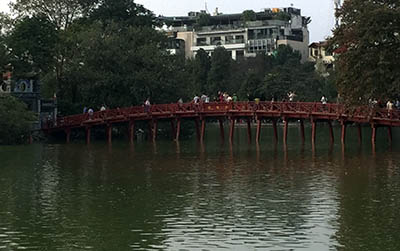Hoan Kiem Lake in the heart of Hanoi
By Dana Sachs
 Hanoi is a city of lakes, brought about over the centuries by the Red River's
myriad floods, expansions, and diversions. The lakes invested the crowded
neighborhoods with light and air and a sense of space that made quite livable
what would otherwise be a fairly claustrophobic urban environment. I'd never
seen a lake in Hanoi that wasn't necklaced by benches and circled by people
out enjoying the view. People fished in them, swam in them, and waded out
into them to harvest wild rau muong, a waterborne vegetable that could
add a few extra vitamins to a bowl of rice.
Hanoi is a city of lakes, brought about over the centuries by the Red River's
myriad floods, expansions, and diversions. The lakes invested the crowded
neighborhoods with light and air and a sense of space that made quite livable
what would otherwise be a fairly claustrophobic urban environment. I'd never
seen a lake in Hanoi that wasn't necklaced by benches and circled by people
out enjoying the view. People fished in them, swam in them, and waded out
into them to harvest wild rau muong, a waterborne vegetable that could
add a few extra vitamins to a bowl of rice.
 Hoan Kiem Lake wasn't Hanoi's biggest, or its deepest. It wasn't even the
cleanest. But it represented the spiritual heart of the city. It was possible
to stroll its circumference in less than thirty minues, but the role it played
in Hanoians' sense of their city -- both historically and in the present day
-- was enormous. The lake drew people toward it as a body draws breath. I
had seen the crowds at the lake on Liberation Day, thousands of revelers on
their bicycles and motorbikes, moving slowly, packed tight, endlessly circling
the lake. During the wedding season, I'd seen professional photographers snap
shots of brides and grooms on the green lawns beside the water. Traditionally,
at midnight on the first night of the Tet New Year celebration, the most signiificant
moment in Vietnam's year, the smoke cloud of a millioin exploding firecrackers
covered the lake like a blanket on a newborn. Hanoians didn't even call Hoan
Kiem Lake by its popular name, but used a shorthand term of endearment, bo
ho, "the shore of the lake." No one had to ask, which shore?
which lake? Bo ho wasn't merely the heart of the city, but its lungs,
and mind, and soul as well.
Hoan Kiem Lake wasn't Hanoi's biggest, or its deepest. It wasn't even the
cleanest. But it represented the spiritual heart of the city. It was possible
to stroll its circumference in less than thirty minues, but the role it played
in Hanoians' sense of their city -- both historically and in the present day
-- was enormous. The lake drew people toward it as a body draws breath. I
had seen the crowds at the lake on Liberation Day, thousands of revelers on
their bicycles and motorbikes, moving slowly, packed tight, endlessly circling
the lake. During the wedding season, I'd seen professional photographers snap
shots of brides and grooms on the green lawns beside the water. Traditionally,
at midnight on the first night of the Tet New Year celebration, the most signiificant
moment in Vietnam's year, the smoke cloud of a millioin exploding firecrackers
covered the lake like a blanket on a newborn. Hanoians didn't even call Hoan
Kiem Lake by its popular name, but used a shorthand term of endearment, bo
ho, "the shore of the lake." No one had to ask, which shore?
which lake? Bo ho wasn't merely the heart of the city, but its lungs,
and mind, and soul as well.
